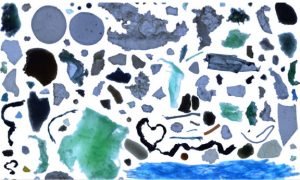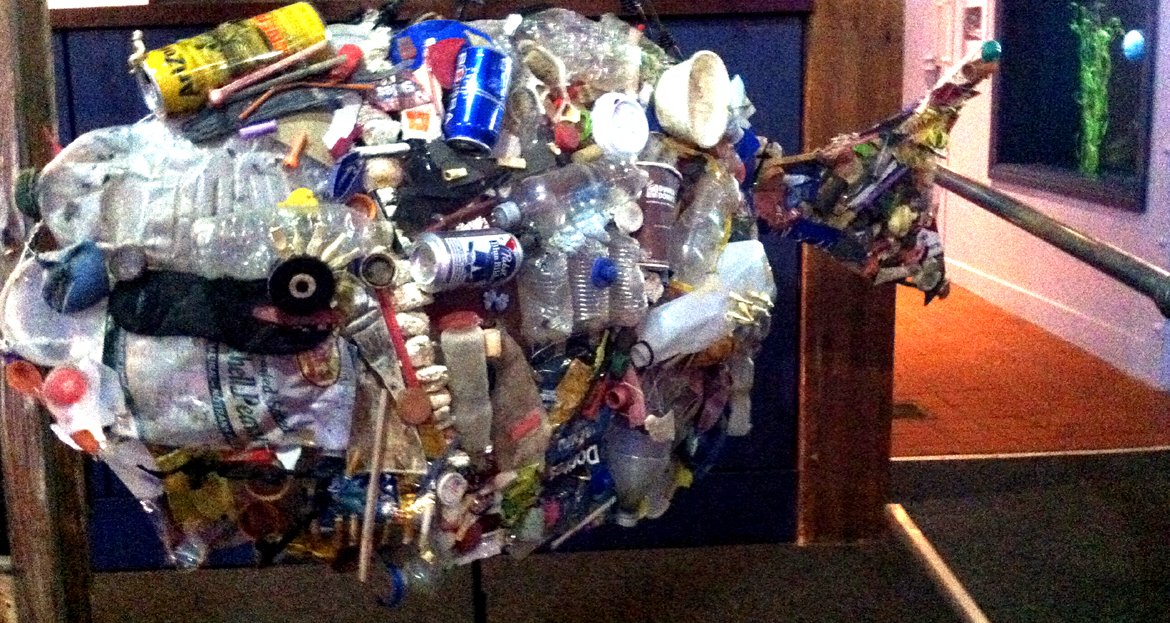Freshwater is a precious resource we are lucky to have in abundance in our backyard – our Great Lakes support the largest freshwater fishery, billions in tourism revenue, and drinking water for over 11 million people.
What We Know About Plastic Marine Debris
One of the main types of marine debris that you hear about today is plastic Marine debris. The word “plastic” is used to describe a collection of artificial or man made chemical compounds that come in about as many shapes, sizes and colors as you can imagine. Examples are styrofoam carryout containers and bottles caps; two common items found in our oceans and waterways. Plastics are used in many aspects of daily life and are a big part of our waste and recycling stream. Plastics last a long time and will degrade into small pieces until you can’t see them anymore. This process happens slower in water than on land. Most commonly used plastics do not mineralize (or go away) i n our oceans, lakes, rivers and streams but instead break down into smaller and smaller pieces. These pieces are called microplastics and are generally less than 5mm long. Bio-based plastics break down in a compost pile or landfill, but are generally not designed to degrade as quickly in the ocean. Plastic has the potential to harm fish and other wildlife in two main ways: direct impacts and indirect impacts. Studies have shown that fish and other marine life do eat plastic. If plastics are kept in the gut instead of passing through, the fish could feel full (of plastic not food) which leads to malnutrition and starvation.
n our oceans, lakes, rivers and streams but instead break down into smaller and smaller pieces. These pieces are called microplastics and are generally less than 5mm long. Bio-based plastics break down in a compost pile or landfill, but are generally not designed to degrade as quickly in the ocean. Plastic has the potential to harm fish and other wildlife in two main ways: direct impacts and indirect impacts. Studies have shown that fish and other marine life do eat plastic. If plastics are kept in the gut instead of passing through, the fish could feel full (of plastic not food) which leads to malnutrition and starvation.
What can you do?
- It’s important to get involved and participate in local cleanups in your area.
- Remember that the land and sea, no matter where you are, are connected.
- Reduce the amount of waste you produce.
- Reuse items whenever possible
- Recycle as much as possible – plastic bottles, cans, paper, cardboard, cell phones, ink cartridges, tires and much more. Check Oberlin’s city website so you know what to throw in your recycling cart and our recycling drop-off programs.
 According to the Nation Oceanic & Atmospheric Administration (NOAA), marine debris spoils the unique beauty of the Great Lakes region, a complex system of habitats, wetlands, rivers, and tributaries. Debris in the Great Lakes ranges from small items, including microplastics and other litter, to large abandoned and derelict vessels. No matter the size or type, debris harms the environment, wildlife and natural resources, creates health and safety hazards, and threatens the Great Lakes’ robust recreational fishing and boating economy. The NOAA Marine Debris Program has worked with partners in the region to prevent marine debris from entering the Great Lakes through education, outreach, and removal projects.
According to the Nation Oceanic & Atmospheric Administration (NOAA), marine debris spoils the unique beauty of the Great Lakes region, a complex system of habitats, wetlands, rivers, and tributaries. Debris in the Great Lakes ranges from small items, including microplastics and other litter, to large abandoned and derelict vessels. No matter the size or type, debris harms the environment, wildlife and natural resources, creates health and safety hazards, and threatens the Great Lakes’ robust recreational fishing and boating economy. The NOAA Marine Debris Program has worked with partners in the region to prevent marine debris from entering the Great Lakes through education, outreach, and removal projects.
Cleveland youth and volunteers have been participating in the Adopt-a-Beach program since 2008. Each year Alliance staff meets with city partners to share and compare results for water sampling and discuss their top litter findings. In addition, groups discuss how to use the data collected to improve beach health.
Recycling is not only a way to reduce your impact, but also a great way to prevent marine debris! The best solution for preventing marine debris is don’t litter and pick up any litter you find, disposing of it properly!
Great Lakes Action Plan – Plastic-Free Great Lakes provides an advocacy toolkit where you’ll find lessons from all levels of government across the Great Lakes region, and sample policies designed to reduce plastic pollution.
Click here for information.
____________________________________________
News Articles Relating to Plastic and Plastic Marine Debris:
What is Microfiber Pollution and How Can We Stop It?
Facebook: https://www.facebook.com/storyofstuff/videos/820193474978884/
Cleveland.com – How many tiny bits of plastic are finding their way from Lake Erie into our drinking water? https://www.youtube.com/watch?v=PBhakv9DQFQ&feature=youtu.be
The New Daily -‘From the highest mountains to the deepest ocean trenches’: How ocean plastics pollute the Earth:https://bit.ly/3QvDfBG
Plastic Used During COVID-19 Pandemic Severely Hampering Wildlife: Study
This is What 200 Tons of Marine Debris Looks Like… From Just 12 Miles of Alaska’s Coastline
Car Engine Cover, Fishing Net and Plastic Bucket Found in Stomachs of Dead Sperm Whales
Online Portal for Marine Litter
Large amounts of litter have accumulated across all parts of our oceans in less than fifty years. Litter has thus become a serious threat to the marine environment, aquatic life and humankind, whose welfare is closely linked with ocean health. Research on marine litter is currently taking a great leap forward and has substantially increased our knowledge of the amount and composition of litter as well as its impacts on the marine environment, aquatic life and people. However, the sheer number of studies scattered all around the globe has rendered this topic increasingly intangible making it difficult for policy makers, public authorities, media and the general public to unearth important information needed to address the urgent questions. LITTERBASE summarizes results from over 1,000 scientific studies in understandable global maps and figures and opens scientific knowledge on marine litter to the public.


